Concept Learning
borrowed from :
http://www.userwebs.pomona.edu/~jbm04747/courses/spring2003/cs151/lectures/VersionSpaces/VersionSpaces.html
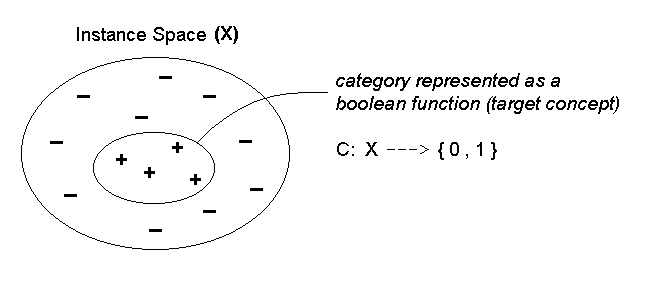
Examples:
-
"bird"
-
"car"
-
"Impressionist painting"
-
"catch-22 situation"
-
"days that are good for enjoying my favorite water
sport"
A Concept Learning Task
Represent days (i.e., instances) using a set of attributes:
-
Sky: Sunny,
Cloudy, Rainy
-
Temp: Warm, Cold
-
Humidity: Normal, High
-
Wind: Strong, Weak
-
Water: Warm, Cool
-
Forecast: Same, Change
Represent hypothesis as a conjunction of
constraints on
attribute values.
Possible attribute constraints:
-
single required value (e.g., Water
= Warm)
-
any value is acceptable: ?
-
no value is acceptable: Ø
Example:
< Sky=Sunny,
Temp=?,
Humidity=High,
Wind=?,
Water=?,
Forecast=?
>
or just
<
Sunny,
?,
High, ?, ?, ? >
This is equivalent to a (restricted) logical
expression:
Sky(Sunny)
^ Humidity(High)
Most general hypothesis: < ?, ?, ?,
?,
?, ? >
Most specific hypothesis: < Ø,
Ø,
Ø, Ø, Ø, Ø >
Positive and negative training examples for the
concept
EnjoySport:
| Example |
Sky |
Temp |
Humidity |
Wind |
Water |
Forecast |
EnjoySport |
| 1 |
Sunny |
Warm |
Normal |
Strong |
Warm |
Same |
Yes |
| 2 |
Sunny |
Warm |
High |
Strong |
Warm |
Same |
Yes |
| 3 |
Rainy |
Cold |
High |
Strong |
Warm |
Change |
No |
| 4 |
Sunny |
Warm |
High |
Strong |
Cool |
Change |
Yes |
Task is to search hypothesis space for a hypothesis
consistent
with examples.
Inductive learning hypothesis:
Any hypothesis found to approximate
the target function well over
a sufficiently large set of training
examples will also approximate
the target function well over other
unobserved examples.
In this case, space is very small:
1 + ( 4 · 3
·
3 · 3 · 3 · 3 ) = 973
Ø + ( {Sunny,
Cold,
Rainy, ?} · { Warm, Cold, ? } · . .
.
)
Need a way of searching very large or infinite
hypothesis
spaces efficiently.
General-to-Specific Ordering
Hypothesis space H has a natural structure.
h1
= < Sunny, ?, ?, Strong, ?, ? >
h2
= < Sunny, ?, ?, ?, ?, ? >
h2 > h1 ("more
general than or equal to")
> relation defines a partial-order
on H.
-
h1 can be generalized to
h2
-
h2 can be specialized to
h1
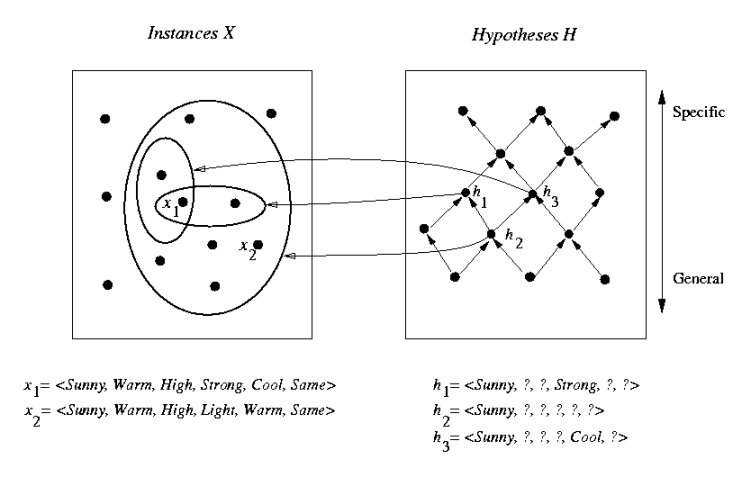
We can use this structure to search for a hypothesis
consistent
with the examples.
FIND-S Algorithm
Finds a maximally specific hypothesis.
h
<--
most specific hypothesis in H
for each positive training
example
x
{
for
each attribute
constraint a in h {
if constraint a is not satisfied by x {
replace a by next more general constraint that is satisfied by x
}
}
}
output hypothesis h |
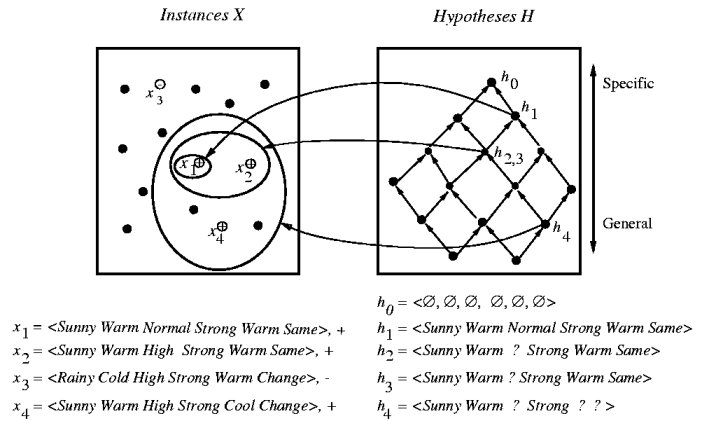
This method works, provided that:
-
H contains a hypothesis that describes the
true target
concept
-
No errors in training data
-
Hypotheses in H described as conjunctions
of attribute
constraints
Problems with FIND-S
-
Cannot determine if final h is the only
hypothesis
in H consistent with the data. There may be many other
consistent
hypotheses.
-
Why prefer most specific hypothesis? Why not
most general
consistent hypothesis (or one of intermediate generality)?
-
Fails if training data is noisy or
inconsistent. Cannot
detect inconsistent training data.
-
Cannot handle hypothesis spaces that may have
several consistent
maximally-specific hypotheses.
-
Not a problem with hypothesis representation used
above,
but may be if more general logical expressions (e.g., with
disjunctions)
are used. Must then use backtracking.
Current-Best-Hypothesis Search
-
uses backtracking and a more general hypothesis
representation
(arbitrary logical expressions, including disjunctions)
-
does not necessarily start from
most-specific-possible hypothesis
Example:
| Sky |
Temp |
Humidity |
Wind |
Water |
Forecast |
EnjoySport |
| Sunny |
Warm |
Normal |
Strong |
Cool |
Change |
Yes |
| Cloudy |
Warm |
Normal |
Strong |
Cool |
Change |
Yes |
| Rainy |
Warm |
Normal |
Strong |
Cool |
Change |
No |
Not possible to find a consistent hypothesis using
FIND-S.
FIND-S: < ?, Warm, Normal,
Strong, Cool,
Change > won't work
CBH: (Sky(Sunny) v Sky(Cloudy))
^ Temp(Warm) ^ . . . ^ Forecast(Change)
Version Spaces
Idea: output the set of all hypotheses
consistent with training data, rather than just one (of possibly many).
No need to explicitly enumerate all consistent
hypotheses.
Take advantage of partial ordering of H.
|
The version space VSH,D
with respect to hypothesis space H and training examples D,
is the subset of hypotheses from H consistent with the training
examples D.
|
How to represent a version space?
One approach: Just list all the members.
List-Then-Eliminate Algorithm
VS <--
a
list of all hypotheses in H
for each training example <x,
f(x)> {
remove
from
VS any hypothesis
h such that h(x) != f(x)
}
output hypotheses in VS
|
Only works if H is finite and small (usually
an
unrealistic assumption).
Better representation for version spaces: Use
2
boundary sets:
-
S-set: least general (i.e.,
most specific)
members of H
-
G-set: most general members of H
VS is the interval from S-set to G-set.
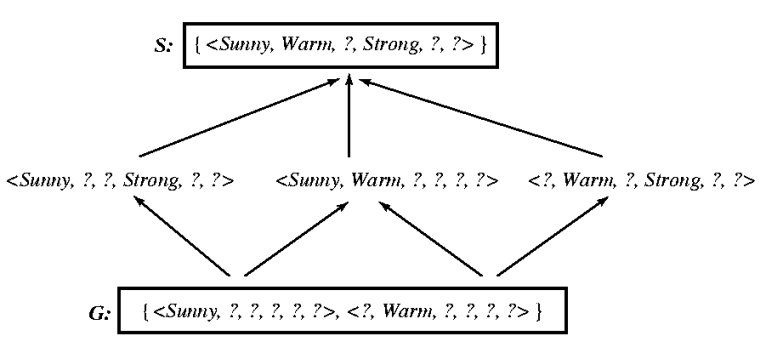
-
Total of 6 possible hypotheses consistent with EnjoySport
training data
-
FIND-S only returns one of these (the most specific
one)
-
Principle of least-commitment (like in
partial-order
planning algorithm)
-
All consistent hypotheses can be enumerated from
S-set and
G-set
Version-Space Learning Algorithm
|
G <-- set of maximally
general
hypotheses in H (e.g., {<?,?,?,?,?,?>})
S <-- set of maximally
specific hypotheses
in H (e.g.,
{<Ø,Ø,Ø,Ø,Ø,Ø>})
for each training example e {
if e is a positive
example
{
remove
from
G any hypotheses inconsistent with e
for
each hypothesis s in S not consistent with e {
1. remove s from S
2. add to S all minimal generalizations h of s
such that
h is consistent with e, and some member of G
is more
general than h
3. remove from S any hypothesis that is more general
than another
hypothesis in S
}
}
if e is a negative
example
{
remove
from
S any hypotheses inconsistent with e
for
each hypothesis g in G not consistent with e {
1. remove g from G
2. add to G all minimal specializations h of g
such that
h is consistent with e, and some member of S
is more
specific than h
3. remove from G any hypothesis that is less general
than another
hypothesis in G
}
}
}
|
Example trace
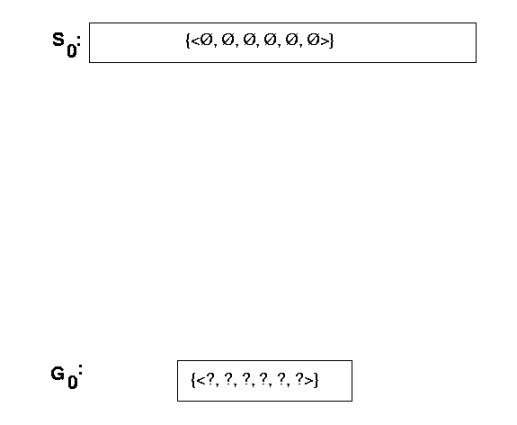




Behavior of Version-Space Learning
-
VS will converge to hypothesis that
correctly describes
target concept if:
-
no errors in training examples
-
H contains a hypothesis that correctly
describes target
concept
-
VS can be monitored to determine how "close"
it is
to the true target concept
-
if S and G converge to a single,
identical
hypothesis, then target concept has been learned exactly
-
VSL algorithm removes from VS every
hypothesis inconsistent
with each example, so the first incorrect/noisy example will eliminate
the target concept from VS !
-
if S and G converge to the empty
set, then
no hypothesis in H is consistent with all training examples
-
VSL algorithm can thus detect inconsistencies in
training
data, assuming that the target concept is representable in H
How can Experiment-Generator module use current VS
to suggest new problems to try?
-
Choose an instance that is classified as positive
by half
of the VS hypotheses, and as negative by the other half
-
Example: < Sunny, Warm, Normal, Light,
Warm,
Same > satisfies 3 out of 6 hypotheses in VS of earlier
example
Partially-learned concepts (VS with > 1
hypothesis)
can still be useful
-
if all hypotheses in VS agree on a
particular
novel instance, then classification must be correct
-
if an instance satisfies all hypotheses s
in S,
then instance must be positive
-
if an instance is rejected by all hypotheses g
in
G, then instance must be negative
-
above two tests can be done efficiently (no need to
test
all hypotheses in VS)
-
if hypotheses in VS give a mixture of
positive and
negative classifications, we can output a probability of correct
classification
(or use majority vote)
Example:
| New instance |
Sky |
Temp |
Humidity |
Wind |
Water |
Forecast |
EnjoySport |
| A |
Sunny |
Warm |
Normal |
Strong |
Cool |
Change |
? |
| B |
Rainy |
Cold |
Normal |
Light |
Warm |
Same |
? |
| C |
Sunny |
Warm |
Normal |
Light |
Warm |
Same |
? |
| D |
Sunny |
Cold |
Normal |
Strong |
Warm |
Same |
? |
VS from earlier example says:
-
all hypotheses agree that A is positive
-
all hypotheses agree that B is negative
-
3 hypotheses say C is positive, 3 say negative
(useful as
a test to gain more info)
-
2 hypotheses say D is positive, 4 say negative (67%
confidence
that it is negative)









